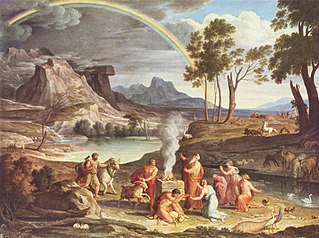

A weather god or goddess, also frequently known as a storm god or goddess, is a deity in mythology associated with weather phenomena such as thunder, snow, lightning, rain, wind, storms, tornadoes, and hurricanes. Should they only be in charge of one feature of a storm, they will be called after that attribute, such as a rain god or a lightning/thunder god. This singular attribute might then be emphasized more than the generic, all-encompassing term "storm god", though with thunder/lightning gods, the two terms seem interchangeable. They feature commonly in polytheistic religions, especially in Proto-Indo-European ones.
Contents
- Africa and the Middle East
- Sub-Sahara Africa
- Afroasiatic Middle East
- Western Eurasia
- Albanian
- Balto-Slavic
- Celtic
- Germanic
- Greco-Roman
- Western Asia
- Uralic
- Asia-Pacific / Oceania
- Chinese
- Filipino
- Japanese
- Vietnamese
- Oceania
- Native Americas
- Central America, South America and the Caribbean
- See also
- References
- Further reading
Storm gods are most often conceived of as wielding thunder and/or lightning (some lightning gods' names actually mean "thunder", [1] [2] [3] but since one cannot have thunder without lightning, they presumably wielded both). The ancients didn't seem to differentiate between the two, which is presumably why both the words "lightning bolt" and "thunderbolt" exist despite being synonyms. Of the examples currently listed storm themed deities are more frequently depicted as male, but both male and female storm or other rain, wind, or weather deities are described.





